Gamut Boundary Distortion Arises from Quantization Errors in Color Conversion
Abstract
1. Introduction
2. Establishment of Color Gamut Model and Conversion Model
2.1. Establishment of RGB–xyY Model
2.2. Establishment of XYZ–X’Y’Z’ Model for Color Gamut Conversion
3. Quantization Error Analysis
3.1. Quantization Color Difference Formula
3.2. Using the Laplace Operator to Describe Quantization Errors in Color Gamut Conversion
4. Conclusion Analysis
4.1. Results Description
4.2. Solutions to the Distortion Problem
5. Conclusions
Author Contributions
Funding
Data Availability Statement
Acknowledgments
Conflicts of Interest
References
- Tsai, T.H.; Lin, S.W. FPGA-based control system for real-time driving of UHD Micro-LED display with color calibration. Integration 2024, 98, 102237. [Google Scholar] [CrossRef]
- Wen, Z.; Zhou, Z.; Liu, H.; Wang, Z.; Li, X.; Fang, F.; Wang, K.; Teo, K.L.; Sun, X.W. Color revolution: Toward ultra-wide color gamut displays. J. Phys. D Appl. Phys. 2021, 54, 213002. [Google Scholar] [CrossRef]
- Mantiuk, R.; Daly, S.; Kerofsky, L. Display adaptive tone mapping. ACM Trans. Graph. 2008, 27, 1–10. [Google Scholar] [CrossRef]
- Subramani, B.; Veluchamy, M. Bilateral tone mapping scheme for color correction and contrast adjustment in nearly invisible medical images. Color Res. Appl. 2023, 48, 748–760. [Google Scholar] [CrossRef]
- International Commission on Illumination (CIE). Recommendations on Uniform Color Spaces, Color-Difference Equations, Psychometric Color Terms; Bureau Central de la CIE: Vienna, Austria, 1978. [Google Scholar]
- Sugawara, M.; Choi, S.Y.; Wood, D. Ultra-High-Definition Television (Rec. ITU-R BT.2020): A Generational Leap in the Evolution of Television [Standards in a Nutshell]. IEEE Signal Process. Mag. 2014, 31, 170–174. [Google Scholar] [CrossRef]
- Chen, H.W.; Lee, J.H.; Lin, B.Y.; Chen, S.; Wu, S.T. Liquid crystal display and organic light-emitting diode display: Present status and future perspectives. Light-Sci. Appl. 2018, 7, 17168. [Google Scholar] [CrossRef] [PubMed]
- Ajito, T.; Ohsawa, K.; Obi, T.; Yamaguchi, M.; Ohyama, N. Color conversion method for multiprimary display using matrix switching. Opt. Rev. 2001, 8, 191–197. [Google Scholar] [CrossRef]
- Sharma, G.; Rodriguez-Pardo, C.E. Geometry of Multiprimary Display Colors I: Gamut and Color Control. IEEE Access 2021, 9, 96573–96597. [Google Scholar] [CrossRef]
- Takeuchi, M.; Sakamoto, Y.; Yokoyama, R.; Sun, H.; Matsuo, Y.; Katto, J. Gamut-Extension Methods Considering Color Information Restoration. IEEE Access 2019, 7, 80146–80158. [Google Scholar] [CrossRef]
- Stiles, W.; Burch, J.M. Interim Report to the Commission Internationale de l’Eclairage, Zurich, 1955, on the National Physical Laboratory’s Investigation of Colour-matching (1955). Opt. Acta Int. J. Opt. 1955, 2, 168–181. [Google Scholar] [CrossRef]
- Li, T.; Yao, B.; Zhu, L.; Deng, L.; Yang, Y.; Chen, Y.; Xu, L.; Gu, C. Color gamut extension algorithm for various images based on laser display. Opt. Express 2024, 32, 3891–3911. [Google Scholar] [CrossRef] [PubMed]
- Rodriguez-Pardo, C.E.; Sharma, G.; Speigle, J.; Feng, X.F.; Sezan, I. Efficient Computation of Display Gamut Volumes in Perceptual Spaces. In Proceedings of the 19th Color and Imaging Conference—Color Science and Engineering Systems, Technologies, and Applications, San Jose, CA, USA, 7–11 November 2011; pp. 132–138. [Google Scholar]
- Wyszecki, G.; Stiles, W.S. Color Science: Concepts and Methods, Quantitative Data and Formulae; John Wiley & Sons: Hoboken, NJ, USA, 2000. [Google Scholar]
- He, G.; Zheng, L. A model for LED spectra at different drive currents. Chin. Opt. Lett. 2010, 8, 1090–1094. [Google Scholar] [CrossRef]
- Brainard, D.H. Color Appearance and Color Difference Specification. In The Science of Color, 2nd ed.; Elsevier: Amsterdam, The Netherlands, 2003; pp. 191–216. [Google Scholar] [CrossRef]
- Luo, M.R.; Xu, Q.; Pointer, M.; Melgosa, M.; Cui, G.; Li, C.; Xiao, K.; Huang, M. A comprehensive test of colour-difference formulae and uniform colour spaces using available visual datasets. Color Res. Appl. 2023, 48, 267–282. [Google Scholar] [CrossRef]
- Liu, D.; Xu, G.; Zhang, Q. A discrete scheme of Laplace–Beltrami operator and its convergence over quadrilateral meshes. Comput. Math. Appl. 2008, 55, 1081–1093. [Google Scholar] [CrossRef]
- Kaiser, P.K.; Boynton, R.M. Human Color Vision; Optical Society of America: Washington, DC, USA, 1996. [Google Scholar]
- Xiaoyu, S.; Min, H.; Gong, X.; Wang, D.; Li, X.; Liu, Y. Optimization and Calculation of Acceptable Color Difference for Printed Samples. Acta Opt. Sin. 2025, 45, 0133001. [Google Scholar] [CrossRef]
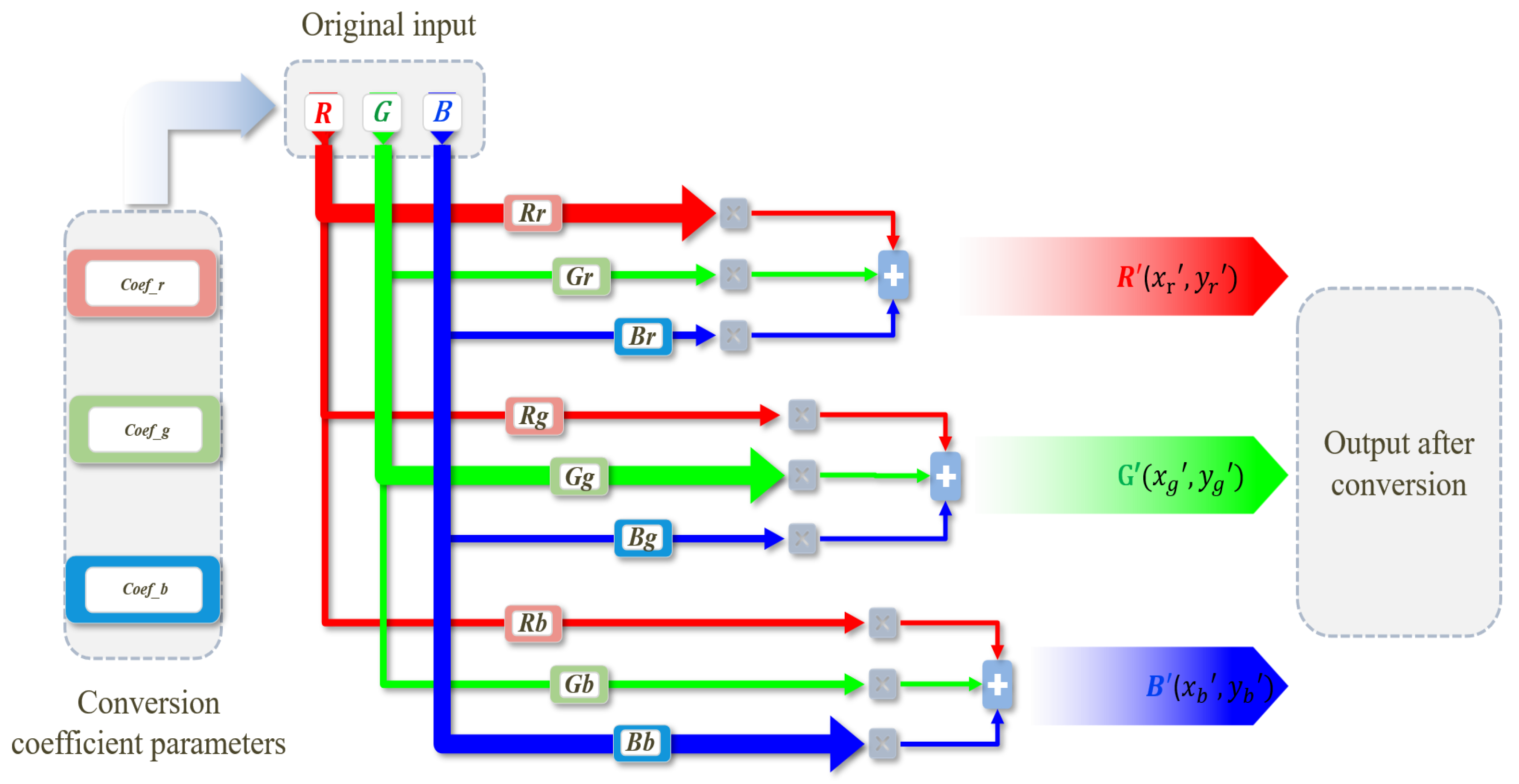
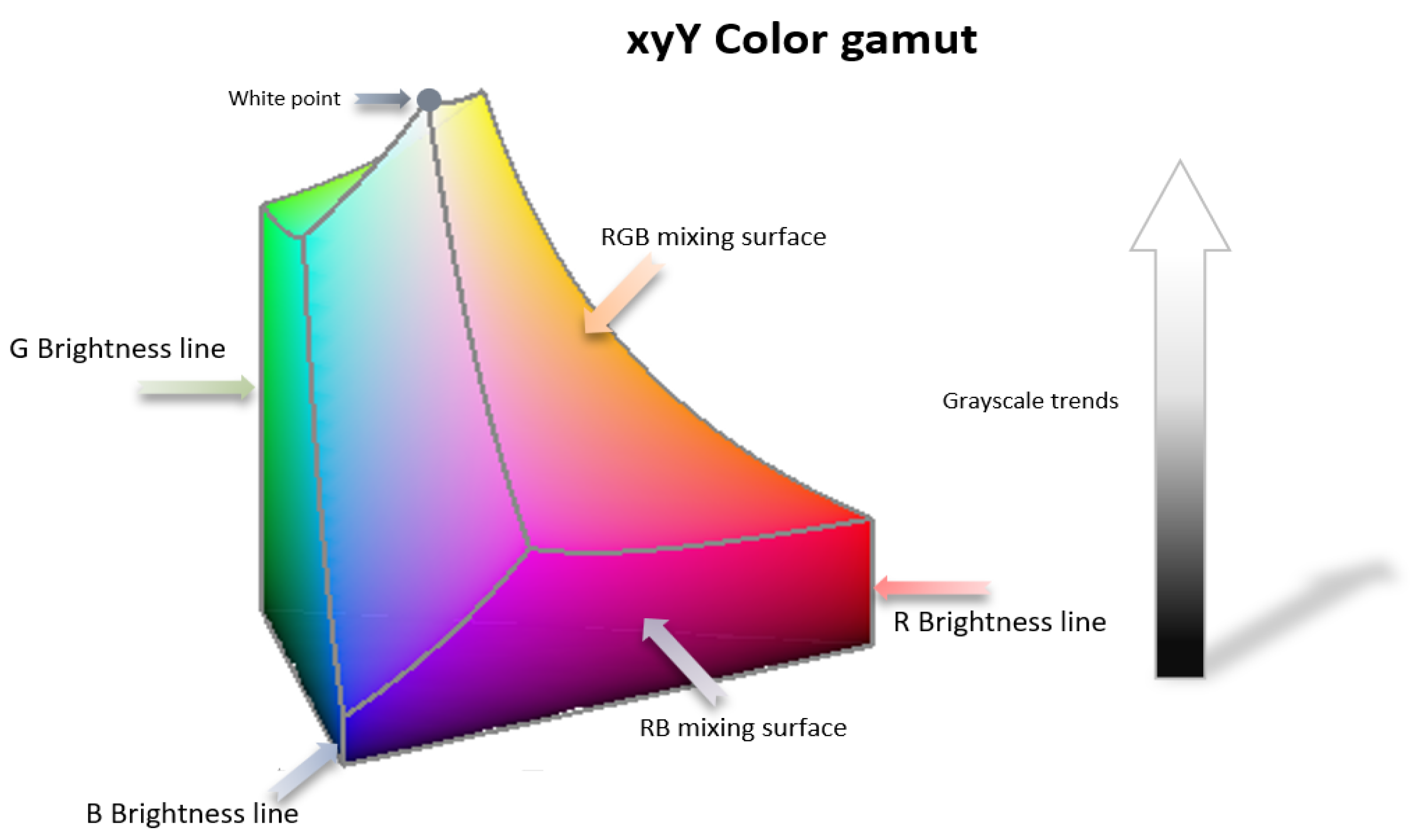
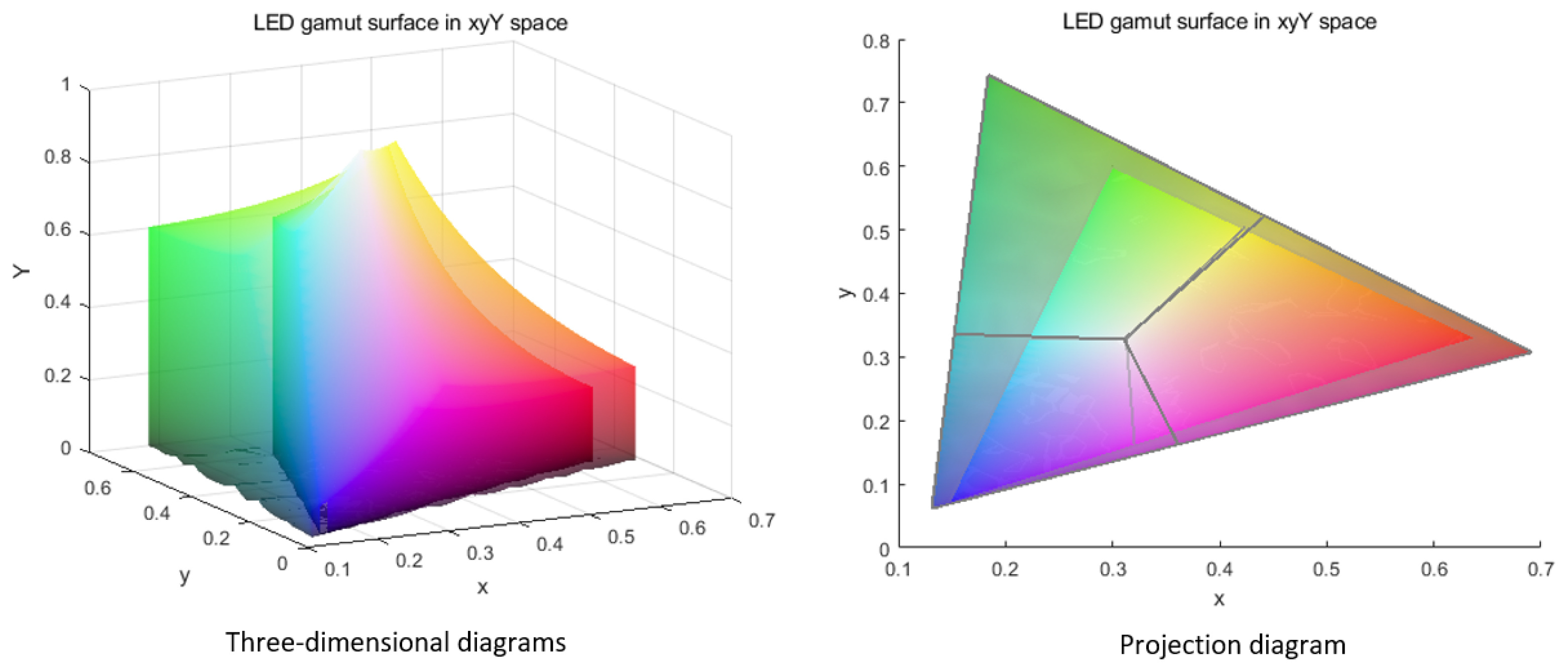

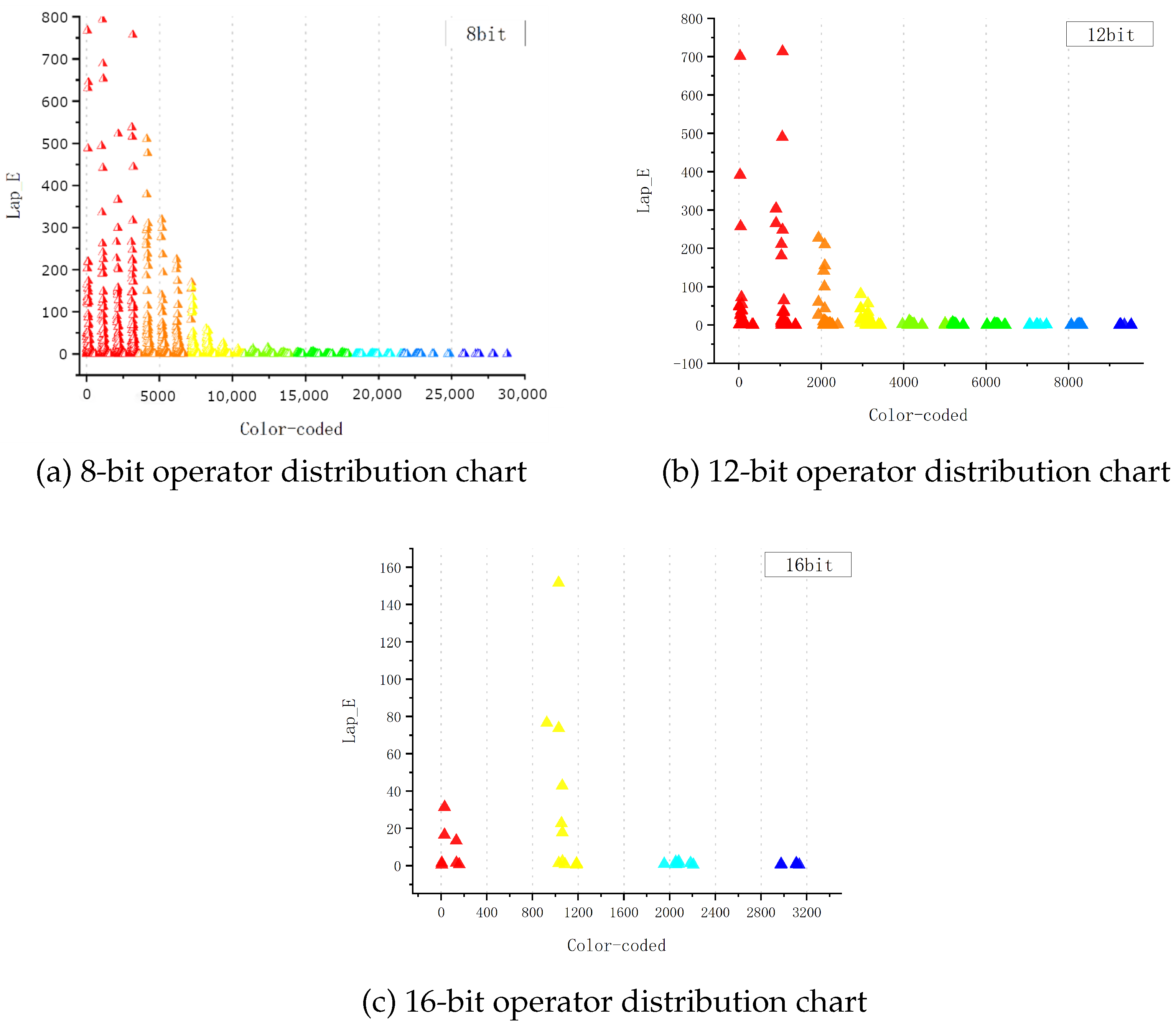
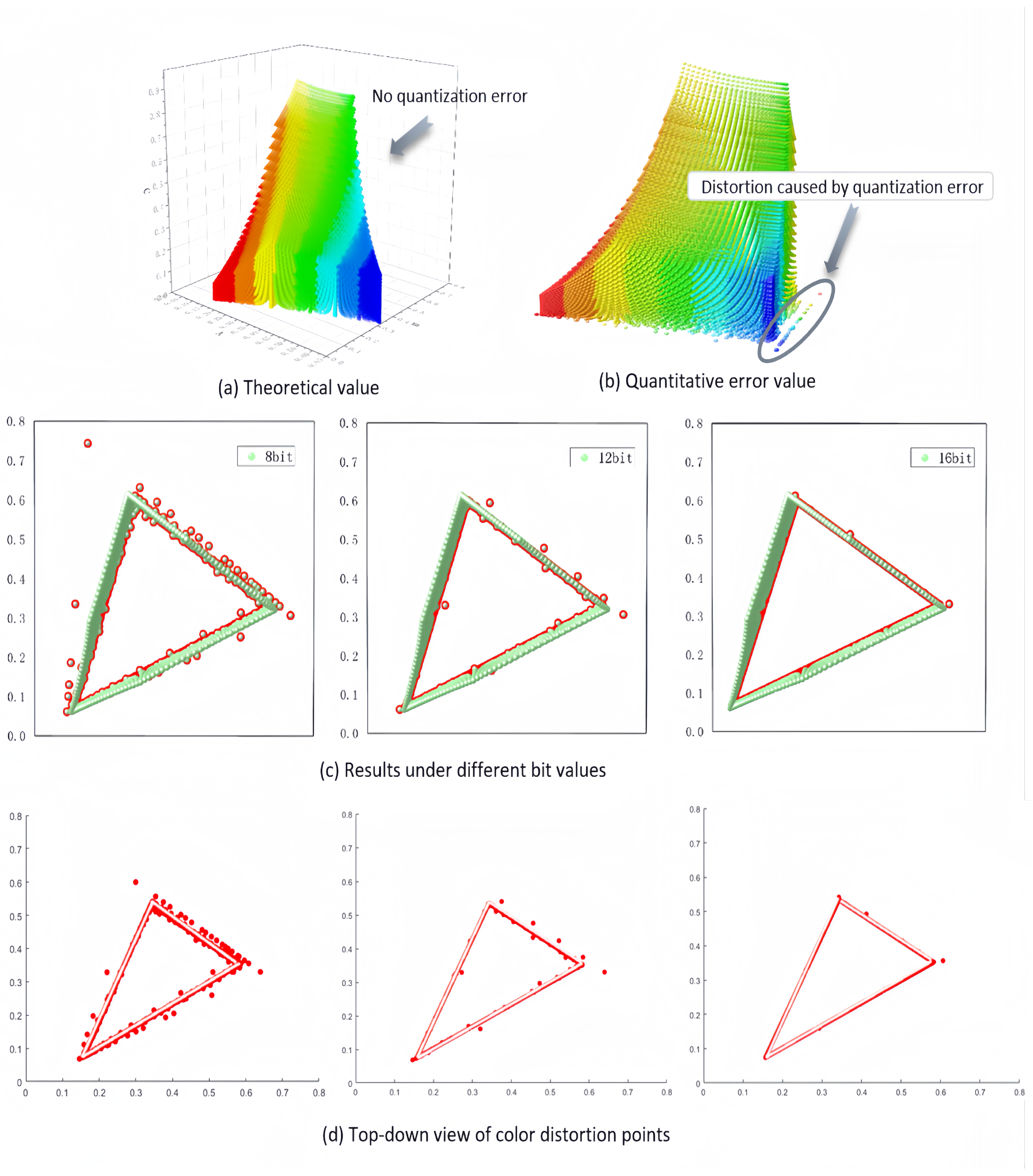
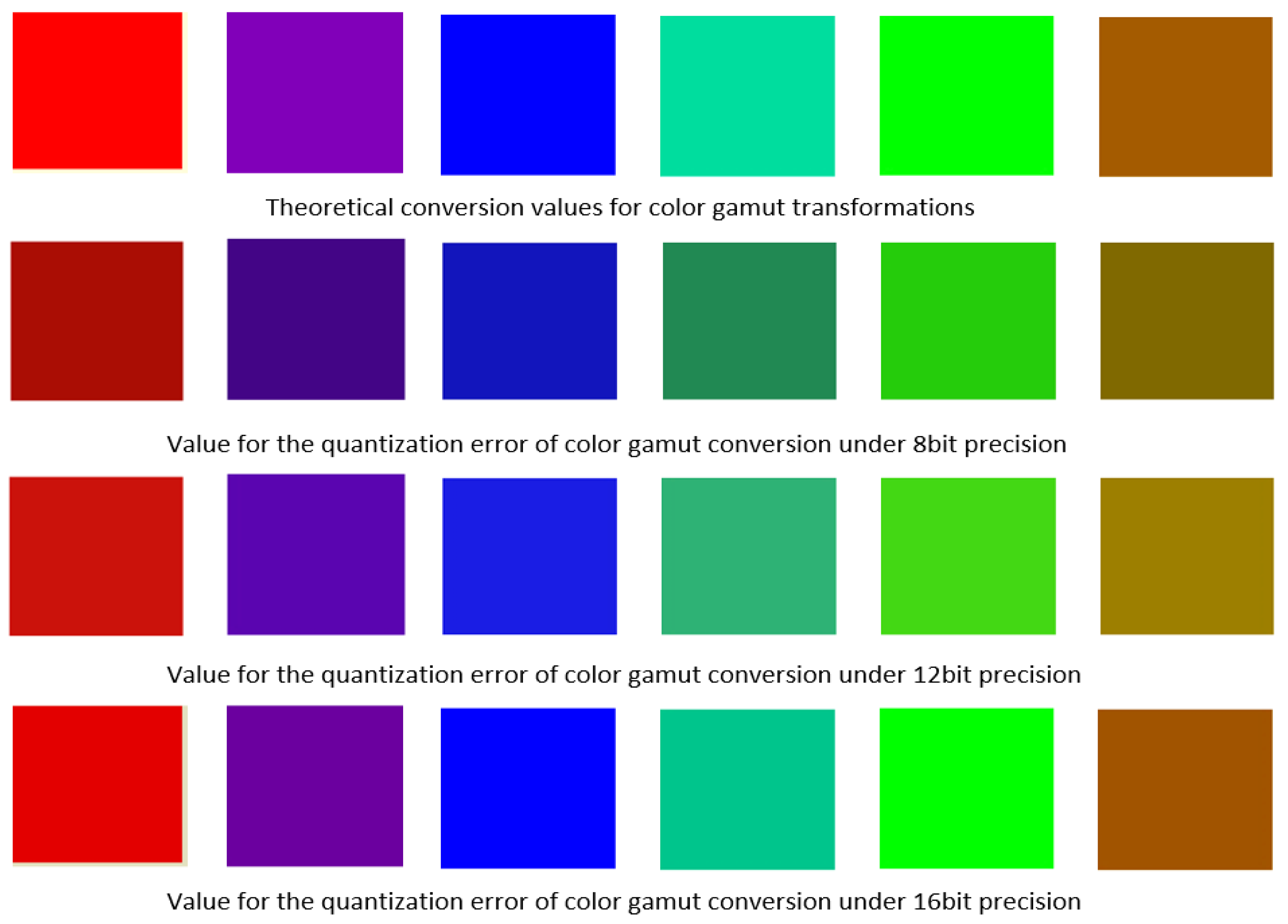
| Quantization Accuracy | R Primary Color | G Primary Color | B Primary Color | |||
|---|---|---|---|---|---|---|
| x | y | x | y | x | y | |
| 8-bit | 0.640 | 0.330 | 0.300 | 0.600 | 0.146 | 0.068 |
| 12-bit | 0.640 | 0.330 | 0.344 | 0.533 | 0.146 | 0.068 |
| 16-bit | 0.606 | 0.357 | 0.343 | 0.542 | 0.157 | 0.074 |
Disclaimer/Publisher’s Note: The statements, opinions and data contained in all publications are solely those of the individual author(s) and contributor(s) and not of MDPI and/or the editor(s). MDPI and/or the editor(s) disclaim responsibility for any injury to people or property resulting from any ideas, methods, instructions or products referred to in the content. |
© 2025 by the authors. Licensee MDPI, Basel, Switzerland. This article is an open access article distributed under the terms and conditions of the Creative Commons Attribution (CC BY) license (https://creativecommons.org/licenses/by/4.0/).
Share and Cite
Li, J.; Zheng, X.; Huang, D.; Liu, F.; Chen, J.; Chen, Y.; Cao, H.; Chen, Y. Gamut Boundary Distortion Arises from Quantization Errors in Color Conversion. Appl. Sci. 2025, 15, 11278. https://doi.org/10.3390/app152011278
Li J, Zheng X, Huang D, Liu F, Chen J, Chen Y, Cao H, Chen Y. Gamut Boundary Distortion Arises from Quantization Errors in Color Conversion. Applied Sciences. 2025; 15(20):11278. https://doi.org/10.3390/app152011278
Chicago/Turabian StyleLi, Jingxu, Xifeng Zheng, Deju Huang, Fengxia Liu, Junchang Chen, Yufeng Chen, Hui Cao, and Yu Chen. 2025. "Gamut Boundary Distortion Arises from Quantization Errors in Color Conversion" Applied Sciences 15, no. 20: 11278. https://doi.org/10.3390/app152011278
APA StyleLi, J., Zheng, X., Huang, D., Liu, F., Chen, J., Chen, Y., Cao, H., & Chen, Y. (2025). Gamut Boundary Distortion Arises from Quantization Errors in Color Conversion. Applied Sciences, 15(20), 11278. https://doi.org/10.3390/app152011278






